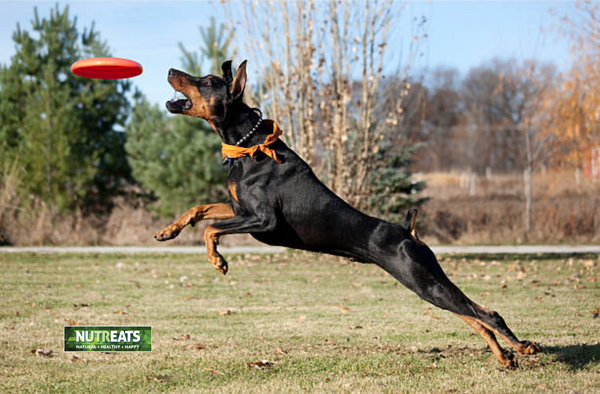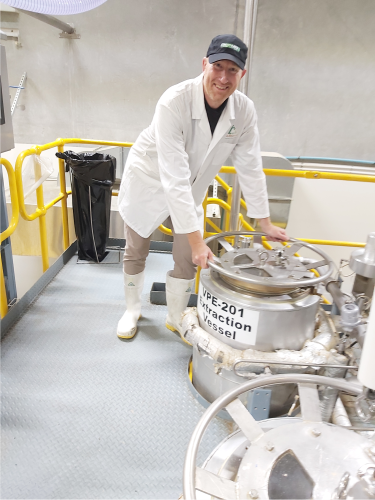Joint Growth Stages in Big Breed Dogs
Ben WintersBig and giant dog breeds, such as Great Danes, Mastiffs, and Labrador Retrievers, experience unique developmental processes, particularly in their joint growth.
These big dog breeds go through a more intricate and extended growth period compared to their smaller counterparts, making their joint health an area of significant interest for owners of big or large breed puppies.
Large and giant dog breeds are typically classified by their size and weight and are distinctly larger than smaller or medium-sized breeds.
The classification of big breed dogs based on their adult weight is as follows:
Large Breed Dogs: These dogs generally weigh between 25 kg and 40 kg when fully grown. Breeds like the Labrador Retriever, Golden Retriever, Boxer, Siberian Husky, Doberman Pinscher, Weimaraner, Rhodesian Ridgeback, and German Shepherd are typical examples of large breeds.
Giant Breed Dogs: These dogs are the true giants of the canine world, with adult weights exceeding 40 kg. This group includes breeds such as the Great Dane, Mastiff, Saint Bernard, Newfoundland, Irish Wolfhound, Leonberger and Bernese Mountain Dog. These giant dog breeds are all known for their impressive size and weight.
There can be considerable variation in size and weight within these categories, even among dogs of the same breed, which highlights the need for customised care and nutrition strategies, especially in relation to their joint health and the joint growth stages from puppyhood to adult dog.

Understanding the joint growth and development in big breed dogs is an essential aspect of ensuring their health and well-being as they become adult dogs.
Due to their large size, these breeds often face unique challenges related to their skeletal structure. Proper bone and joint development of these large dogs is important so that they grow strong and able to support their weight and their level of physical activity.
When joint growth is well-managed, it helps in preventing discomfort and mobility issues, contributing significantly to the overall quality of life for these dogs.
Knowledge about their joint development can guide owners in providing the right nutrition, exercise, and care, specifically tailored to support healthy joints from puppyhood through adulthood.
The rapid growth rate in big breed dogs can put them at risk for developmental issues if their nutritional and physical needs are not adequately met.
By understanding the stages of joint development, owners and veterinarians can work together to monitor and address any potential issues early on.
This proactive approach can help in maintaining optimal joint health, allowing these dogs to lead active and comfortable lives. Additionally, this understanding is needed to make informed decisions regarding diet, supplements like glucosamine and chondroitin, and appropriate exercise regimens, all of which play a pivotal role in nurturing and sustaining the joint health of large and giant dog breeds.

The Early Puppyhood Stage (Birth to 2 Months)
The journey of a big breed dog's growth begins with the early puppyhood stage, lasting from birth until about 2 months of age. During this phase, puppies undergo rapid physical development, but their bones and joints are still quite soft and malleable. Nutrition plays a foundational role here, with their mother's milk providing essential nutrients for initial growth.
This stage is characterised by significant changes in the puppy's body, with a focus on gaining weight and developing basic motor skills. Even though the changes are swift, the actual bone development is still in its infancy, which means the joints are particularly vulnerable to stress and injury.
The Rapid Growth Stage (2 to 6 Months)
As big breed puppies enter the rapid growth stage, typically spanning from 2 to 6 months, their development accelerates. This is when puppies start to show noticeable increases in size and weight. Their bones begin to lengthen, and the growth plates are highly active.
It is important during this stage to provide a diet specifically tailored for large breed puppies, as it helps manage the growth rate and ensures proper bone and joint development.
Overfeeding and excessive calcium intake should be avoided to prevent abnormal growth spurts, which can lead to joint issues later in life.
This stage also marks a critical period for socialisation and the beginning of basic training, which should be approached with an awareness of the puppy’s physical limitations.
The Slowing Growth Stage (6 to 12 Months)
Between 6 to 12 months, the growth rate in big breed puppies starts to slow down. While they continue to grow in size, the rate at which this occurs is more gradual compared to the earlier stages.
During this period, the focus shifts from rapid growth to strengthening and consolidating bone density and joint health.
The diet should still be appropriate for large breed puppies, providing balanced nutrients without excessive calories that could lead to obesity, further straining the developing joints.
Exercise during this stage should be regulated – consistent but not overly strenuous – to support healthy joint and muscle development without causing injury to the still-maturing bones and joints.
Transition to Adulthood (12 Months Onwards)
The transition to adulthood for big breed dogs typically begins around 12 months of age, but it is important to note that some breeds may continue to grow and develop until they are 18 to 24 months old.
In this final stage, the growth plates gradually close and harden, signalling the end of bone growth. The focus of nutrition shifts again, this time towards maintaining a healthy weight and supporting long-term joint health.

Owners should transition their dogs to an adult diet formulated for large breeds, which helps maintain optimal body condition and supports overall health.
Regular exercise remains important, but now the dog's body is more capable of handling varied and intensive activities.
This stage marks the completion of the physical growth process, although big breed dogs will continue to mature mentally and emotionally well beyond their physical growth period.
Healthy joint development in big breed dogs is significantly influenced by their nutrition, therefore the diet of a big breed dog has an impact on their joint development, growth and joint health.
Nutritional imbalances or deficiencies can lead to impaired growth and development of bones and joints, which is particularly concerning in large breeds prone to joint issues.
A diet that is well-balanced, age-appropriate, and breed-specific can help maintain healthy joint function. This includes controlling calorie intake to prevent excessive weight gain, which can put additional strain on the joints.
Additionally, foods rich in omega-3 fatty acids, glucosamine, and chondroitin can provide natural support for joint health.
Recommendations for feeding big breed puppies and dogs for optimal joint health and balanced growth are:
Big Breed Specific Feeds: Try to feed a diet that is specifically formulated for large breed puppies. These diets are designed to support balanced growth and help prevent rapid weight gain.
Controlled Feeding Portions: Avoid overfeeding and monitor the puppy’s body condition regularly. Excess weight can put undue stress on developing joints.
Appropriate Calcium and Phosphorus Levels: Ensure the diet maintains the correct calcium-to-phosphorus ratio to promote healthy bone development without accelerating growth.
Inclusion of Joint-Supporting Nutrients: Look for foods that include glucosamine, chondroitin, and omega-3 fatty acids, or consider adding these as supplements under veterinary guidance.
Regular Veterinary Check-Ups: Regular check-ups can help monitor the puppy's growth rate and joint health, allowing for dietary adjustments as needed.
Gradual Transition to Adult Food: Transition to adult dog food at the appropriate age, which varies by breed. This helps ensure that the dog's nutritional needs are met throughout its different life stages.
By following these recommendations, pet owners can significantly contribute to the long-term joint health and overall well-being of their big breed dogs, ensuring they remain active and healthy throughout their lives.
Glucosamine and chondroitin are two naturally occurring substances that are important for maintaining joint health in dogs, especially in large breeds.
Glucosamine is an amino sugar that is used for building and repairing cartilage, the elastic tissue that cushions joints. It is synthesised naturally in a dog’s body but can also be supplemented through diet or dietary supplements.
Chondroitin, on the other hand, is a substance that occurs naturally in connective tissues. It helps retain water in the cartilage, maintaining its elasticity and shock-absorbing qualities.
Together, these compounds support the resilience and integrity of joints, ensuring that the cartilage remains healthy and capable of withstanding the wear and tear of daily activities.
In big breed dogs, the role of glucosamine and chondroitin becomes even more significant due to the larger stress placed on their joints.
The size and weight of these breeds mean their joints must bear more load, making them more susceptible to wear and deterioration over time.
Supplementing with glucosamine and chondroitin can aid in the maintenance of strong, healthy cartilage, thus supporting joint function and mobility. This is particularly important in the early stages of a dog's life when rapid growth can put added strain on joint development, as well as in older dogs, where joint health often begins to decline.
By incorporating glucosamine and chondroitin into their diet, either through specific foods or supplements, owners can actively contribute to the longevity and well-being of their dog's joints, helping to ensure a more active and comfortable life for these larger breeds.
Understanding the growth stages of a big breed dog, as it grows from puppyhood to adulthood, is important for dog owners so that they can ensure the long-term health and well-being of their large loveable pets.
The growth stages, starting from early puppyhood through the rapid growth phase and slowing down in the pre-adult stage, each present unique challenges and needs. Proper nutrition, tailored to each stage, is needed to support healthy joint development.
Essential nutrients such as glucosamine, chondroitin, calcium, phosphorus, and omega-3 fatty acids are helpful in maintaining dogs' joint health. These nutrients help in building and repairing cartilage, maintaining elasticity, and supporting the overall integrity of the joints.
As pet owners navigate these stages, regular veterinary check-ups, controlled feeding portions, and appropriate exercise regimens become indispensable tools in monitoring and supporting the growth of their big breed dogs.
The proactive management of diet and lifestyle ensures these dogs grow into their large frames with strong and healthy joints, ready to lead active and comfortable lives. The addition of joint-supporting supplements like glucosamine and chondroitin can be particularly beneficial, especially considering the extra load on the joints of larger breeds.






